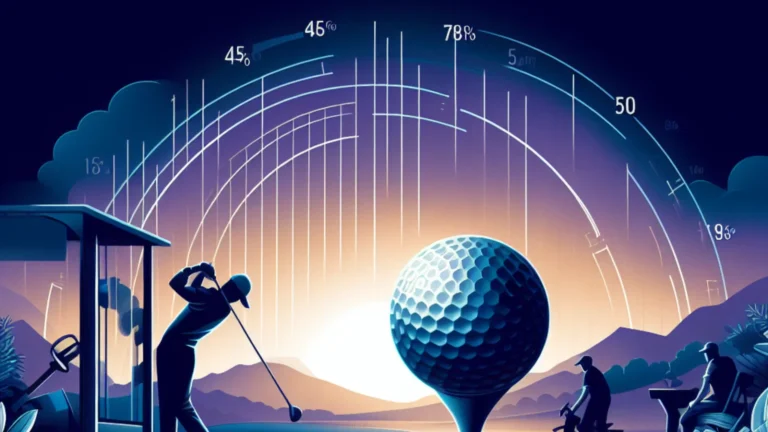The Key Differences Between Chipping and Pitching in Golf
Chipping and pitching are two common shot types that golfers use to hit the ball onto the green from a short distance away. While both chipping and pitching have the end goal of getting the golf ball close to the hole on the putting surface, there are some notable differences between these two shot types that impact how and when you would use them. Understanding the differences between chipping and pitching is key for knowing which option to choose depending on factors like your lie, the distance to the hole, and what kind of roll-out or release you want after the ball lands.
What is Chipping in Golf
Chipping in golf is a short shot typically played from just off the green, used to fly the ball onto the putting surface and have it roll out towards the hole. The hallmarks of a chip shot are a short, low trajectory through the air and letting the ball run and release towards its target once it hits the green. The club most golfers use for chipping is a lofted wedge, allowing the player to get under the ball easily and keep the shot low. Some key characteristics and purposes of chipping in golf include:
- Playing from a tight lie in thick grass or deep rough right off the fringe or collar of the green into the putting surface
- Using loft on the wedge to create a sharp, descending blow to cleanly strike the ball
- Minimizing air time and carry distance so the ball spends more time rolling on the ground.
- Imparting backspin to make the golf ball check up or stop quickly after landing
- Producing more ground release and roll-out after the ball hits the green.
The ideal chipping technique involves creating backspin and landing the chip shot softly so it dies near your target. This is accomplished by moving weight onto your front foot at address and keeping the hands ahead of the clubhead at impact. Overall, chip shots allow golfers to fly the ball a short distance directly onto the putting surface and use the ground to bring it closer to the hole.
What is Pitching in Golf
Pitching is another type of short-game shot in golf where the ball lands onto the green but differs from chipping by having a higher ball flight and less ground roll. Pitches are played from a cleaner lie in the fairway or light rough and use a fuller swing and steeper angle of attack to carry the ball all the way to its landing spot. The clubs of choice for pitching are higher-lofted irons, hybrids, or fairway woods rather than wedges. Some meaningful qualities and uses for pitching on the golf course consist of:
- Producing a much higher ball flight than chipping to carry a shot over hazards or onto an elevated green.
- Allowing the ball to land softly on the green with minimal backspin to limit roll-out
- Covering more total distance in the air when you need to fly the ball over trouble or on longer holes.
- Playing from a better fairway lie versus rough or thick grass around greens
- Executing a fuller swing than chipping for better distance control.
To pitch the ball correctly, golfers use a descending blow striking the ball first then taking a divot after contact. This allows the clubface to retain loft and launch the ball high rather than removing loft and hitting down too steeply. Top priorities for pitch shots are carrying the ball cleanly onto the putting surface and leaving it there with minimal release.
The Key Differences Between Chipping and Pitching
While chipping and pitching in golf share the goal of getting your golf ball onto the green and near the hole, there are several meaningful distinctions between these two short-game shots. The most significant differences golfers should recognize are:
Swing Execution
The chipping motion is a smaller, flick-of-the-wrists swing utilizing mostly arm and hand action. Pitching uses a fuller, wider backswing bringing the club further back before striking the ball. This bigger swing generates more power and lift on the golf ball.
Ball Flight Trajectory
Chips shots have a low, boring trajectory that hugs the ground while pitches launch the ball much higher on a steeper angle thanks to added loft and spin. Pitches allow golfers to fly the ball cleanly over obstacles and water hazards to reach the green.
Lie and Contact
Chip shots are played from uneven lies in thicker grass or tangled rough near the green. This forces golfers to make clean contact on the ball first. Pitches come from cleaner fairway lies allowing solid ball-then-divot contact.
Landing Characteristics
A properly hit chip shot lands softly on the green with plenty of overspin, bites, and stops quickly near its landing zone. Good pitch shots land relatively softly as well but with less spin, so they release a bit more after impact.
Speed off the Face
Chipping emphasizes finesse using a smooth, sweeping motion to generate minimal clubhead speed. Pitch shots center around making crisp contact utilizing fuller swings and faster club speeds at impact.
Roll-Out Potential
Chips rely much more on letting the ball run out on the putting surface after landing rather than carrying in the air. Pitch shots land and stick or release subtly rather than taking off and rolling towards the target.
Shot Distance Covered
Chip shots only fly a few yards onto the fringe or edge of the green and use ground release to reach the pin. Pitching carries the ball airborne for longer portions of the total yardage. Pitches stop closer to where they land.
Club Selection
Chipping utilizes higher-lofted wedges with wide sole widths. Pitching prefers less-lofted irons, hybrids, and fairway woods with thinner soles that don’t dig.
In summary, chipping requires less swing effort to travel shorter air distances to holes using ground roll-out. Pitching relies more on loft and full swings to carry shots further directly to the target landing area.
When to Choose Chipping vs Pitching
Golfers must weigh several factors to decide between hitting a chip shot or opting for a pitch on their second shots into par 4 and par 5 greens. Essentially you must judge your position off the green, the type of grass or lie you’re playing from, the total distance to the hole, and what potential obstacles exist between your ball and the putting surface.
Some of the main considerations for chipping or pitching are:
Lie and Stance
If you have a clean fairway or light rough lie with room for a full swing, pitching is likely the better choice. Tight lies in gnarly grass or brush call for chipping to extricate the ball.
Distance to the Hole
Closer chip shots 30 yards away have room to use ground release. Further pitch shots up to 60 yards out must fly onto the green and stop quickly.
Hazards or Bunkers
Pitches easily clear risky water hazards, traps, and mounds if you execute versus low chips. Chipping provides margin beneath trouble.
Green Contours and Position
If the green is elevated or protected by bunkers chipping remains risky compared to a pitch. Downhill chip shots can also get away from you quickly.
Wind Direction and Speed
Pitching allows flying the ball above gusty winds while chipping keeps shots low avoiding the wind but limiting carry distance potential.
Ultimately you want to match the shot you hit to the situation you face into greens. Uphill or downwind? Pitch. Long carry over water required? Pitch. Buried lie in thick grass? Chip. Extreme precision required? Chip. Gauge each scenario and shot shape accordingly.
Conclusion
Mastering both chipping and pitching provides golfers with two excellent options for hitting greenside approach shots tight to pin placements. Although chipping and pitching share similarities in being short-game shots to get the ball onto the putting surface, they differ substantially in technique, trajectory, spin, landing characteristics, and best use cases. Knowing when to leverage the high-launching, aerial weapon of pitching versus the low-skimming, ground-hugging finesse of chipping based on lie, distance, hazards, and hole locations will lead to more up and downs and lower scores. Train both shots equally to add valuable weapons and flexibility into your golf game.







